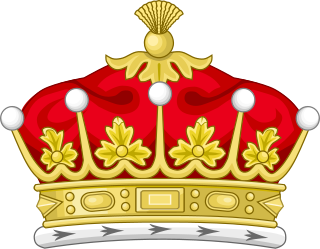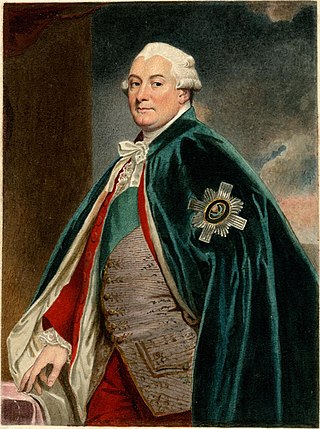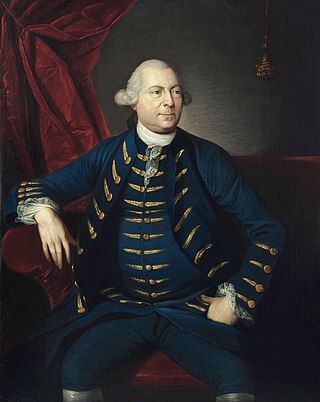Related Research Articles

Thomas Chippendale was a cabinet-maker in London, designing furniture in the mid-Georgian, English Rococo, and Neoclassical styles. In 1754 he published a book of his designs in a trade catalogue titled The Gentleman and Cabinet Maker's Director—the most important collection of furniture designs published in England to that point which created a mass market for furniture—upon which success he became renowned. According to the Victoria and Albert Museum, "so influential were his designs, in Britain and throughout Europe and America, that 'Chippendale' became a shorthand description for any furniture similar to his Director designs".
George Hepplewhite was a cabinetmaker. He is regarded as having been one of the "big three" English furniture makers of the 18th century, along with Thomas Sheraton and Thomas Chippendale. There are no pieces of furniture made by Hepplewhite or his firm known to exist but he gave his name to a distinctive style of light, elegant furniture that was fashionable between about 1775 and 1800 and reproductions of his designs continued through the following centuries. One characteristic that is seen in many of his designs is a shield-shaped chair back, where an expansive shield appeared in place of a narrower splat design.

Earl of Shaftesbury is a title in the Peerage of England. It was created in 1672 for Anthony Ashley-Cooper, 1st Baron Ashley, a prominent politician in the Cabal then dominating the policies of King Charles II. He had already succeeded his father as second Baronet of Rockbourne in 1631 and been created Baron Ashley, of Wimborne St Giles in the County of Dorset, in 1661, and he was made Baron Cooper, of Paulett in the County of Somerset, at the same time he was given the earldom.

David Murray, 2nd Earl of Mansfield, 7th Viscount of Stormont, known as the (7th) Viscount of Stormont from 1748 to 1793, was a British diplomat and politician. He succeeded to both the Mansfield and Stormont lines of the Murray family, inheriting two titles and two fortunes.

The Cabinet-Maker and Upholsterer's Guide is an eighteenth-century reference book about furniture-making. Many cabinetmakers and furniture designers still use it as a reference for making period furniture or designs inspired by the late 18th century era. Historians of domestic life or the History of Technology use it for establishing context for their research. Original copies are also considered valuable as antiques.

David William Murray, 3rd Earl of Mansfield, KT was a British army officer and peer, who served as Lord Lieutenant of Clackmannanshire from 1803 until his death.

Carlton House, sometimes Carlton Palace, was a mansion in Westminster, best known as the town residence of King George IV, particularly during the regency era and his time as prince regent. It faced the south side of Pall Mall, and its gardens abutted St James's Park in the St James's district of London. The location of the house, now replaced by Carlton House Terrace, was a main reason for the creation of John Nash's ceremonial route from St James's to Regent's Park via Regent Street, Portland Place and Park Square: Lower Regent Street and Waterloo Place were originally laid out to form the approach to its front entrance.

Kenwood House is a former stately home in Hampstead, London, on the northern boundary of Hampstead Heath. The house was originally constructed in the 17th century and served as a residence for the Earls of Mansfield during the 18th and 19th centuries.

William Vile was an English cabinetmaker.
John Cobb was an English cabinetmaker and upholsterer.

Dido Elizabeth Belle was a free black biracial British gentlewoman. She was born into slavery and illegitimate; her mother, Maria Belle, was an enslaved Black woman in the British West Indies. Her father was Sir John Lindsay, a British career naval officer who was stationed there; later knighted and promoted to admiral. Lindsay took Belle with him when he returned to England in 1765, entrusting her upbringing to his uncle William Murray, 1st Earl of Mansfield, and his wife Elizabeth Murray, Countess of Mansfield. The Murrays educated Belle, bringing her up as a free gentlewoman at their Kenwood House, together with another great-niece, Lady Elizabeth Murray, whose mother had died. Lady Elizabeth and Belle were second cousins. Belle lived there for 30 years. In his will of 1793, Lord Mansfield provided an outright sum and an annuity to her.

Sir Lawrence Dundas, 1st Baronet was a Scottish merchant and politician.

Ince and Mayhew were a partnership of furniture designers, upholsterers and cabinetmakers, founded and run by William Ince (1737–1804) and John Mayhew (1736–1811) in London, from 1759 to 1803; Mayhew continued alone in business until 1809. Their premises were located in Marshall Street but were listed in London directories in Broad Street, Soho, 1763–83, and in Marshall Street, Carnaby Market, 1783–1809. The partnership's volume of engraved designs, The Universal System of Household Furniture, dedicated to the Duke of Marlborough, was issued in imitative rivalry with Thomas Chippendale; Ince, who was a subscriber to the first edition of Chippendale's Director, was chiefly responsible for the designs, while Mayhew contributed the greater part of the partnership's capital, kept the accounts, and was in closer contact with the firm's clientele among the nobility and gentry. The name of the firm originally appears to have been "Mayhew and Ince", but on the title page of The Universal System the names are reversed, suggesting that Ince was the more extensive contributor.
The St Martin's Lane Academy, a precursor of the Royal Academy, was organised in 1735 by William Hogarth, from the circle of artists and designers who gathered at Slaughter's Coffee House at the upper end of St Martin's Lane, London. The artistic set that introduced the Rococo style to England was centred on "Old Slaughter's" and the drawing-classes at the St. Martin's Lane Academy were inextricably linked in the dissemination of new artistic ideas in England in the reigns of George II and George III.
John (Jean)Pelletier (fl. ca 1681 – 1704) was a French Huguenot carver and gilder, who emigrated from Paris, where he had trained, and worked in London. He provided high-style Baroque furniture for the court of William III and Mary II, specializing in carved, gessoed and gilded furniture of the highest quality. He was also employed in providing carved and gilded picture and looking-glass frames and in gilding the work of other carvers.
Benjamin Goodison, of London, was a royal cabinetmaker to George II of Great Britain, supplying furnishings to the royal palaces from 1727 to the time of his death. He served his apprenticeship with James Moore, who died accidentally in October 1726; Moore was the pre-eminent London cabinetmaker during the reign of George I. Goodison's classicizing case furniture owes much of its inspiration to the neo-Palladian designs of William Kent; outstanding documented examples are the pair of part-gilded mahogany commodes and library writing-tables Goodison made for Sir Thomas Robinson of Rokeby Hall, Yorkshire, now in the Royal Collection; they have boldly-scaled Greek key fret in their friezes and lion masks gripping brass rings heading scrolling consoles at their corners.

William France Jr. was a cabinetmaker and upholsterer in 18th century London and a member of the well known France family who held the Royal Warrant for over half a century. He was the nephew of William France Sr. and younger brother of Edward France, the former being cabinetmaker to the Royal Household. He was born in 1759 and died in 1838 in Boulogne, France. He was made a Freeman of Lancaster in 1785–86.
Edward France was a cabinetmaker and upholsterer in 18th century London and a member of the well known France family who held the Royal Warrant for over half a century. He was the nephew of William France Snr and older brother of William France Jr, both of whom were cabinetmakers to the Royal Household. He was born in 1748 and died in 1777. He was made a Freeman of Lancaster in 1773–74.
Collier and Plucknett were a Warwick, England based Victorian-era furniture maker, best known for their Gothic revival pieces.
Robert Blake was the first of the Blake family of London cabinetmakers. Blake is particularly known for his marquetry and for the ormolu-mounted commodes in tortoiseshell and ebony that he made in 1708–09, after a pair that André-Charles Boulle made for Louis XIV's Chamber at the Grand Trianon, on display in the New York Frick Collection. A pair of Blake commodes, completing the two in the Frick Collection, was sold at Sotheby's on October 15, 2015, for $658,000.
References
- 1 2 3 4 5 6 7 8 9 Geoffrey Castle – 'The France Family of Upholsterers and Cabinet-Makers' – Furniture History Society Journal Vol.XLI pp 25–43, Published 2005
- ↑ Whittington Parish Records, Lancashire Parish Register Society
- 1 2 3 4 Dictionary of English Furniture Makers 1660–1840 by G Beard & C Gilbert, 1986 ( ISBN 0 901286 18 4)
- ↑ Sir Ambrose Heal – 'London Furniture Makers 1660–1840' p189
- ↑ Percy Hetherington Fitzgerald: The good Queen Charlotte, 1899; pages 32–33
- ↑ Ayling, pp. 85–87
- ↑ The National Archives, Kew NA/LC/5/57(26&27), Royal Warrants certificate dated 7 July 1764
- ↑ London, Duchy of Cornwall Archives: Augusta Princess of Wales, household a/c Vol LIV, half yr ending 1 October 1767 total amount £1750 2s 4.75d
- ↑ Eileen Harris, The Furniture of Robert Adam (London:Academy Editions, 1973), p.69 ( ISBN 0854589295)
- ↑ Perth,Scotland: Scone Palace, Mansfield MSS, Kenwood Accounts.
- ↑ The National Archives, Kew (The Lord Chancellors Bill Books)
- 1 2 3 4 5 6 Christopher Gilbert – 'The Life and work of Thomas Chippendale' 1978
- ↑ The National Archives, Kew NA LC/2/33 Duke of Cumberlands funeral
- ↑ National Archives, Kew PRO/LC/9/217
- 1 2 Royal Archives LC Windsor
- ↑ The National Archives, Kew NA LC/9/270, William France's Ledger. In the catalogue of the Lord Chamberlains papers it is recorded as 'Miscellaneous'
- ↑ Westminster City Archives NA PROB/11/985
- ↑ "The National Archives Documents Online".